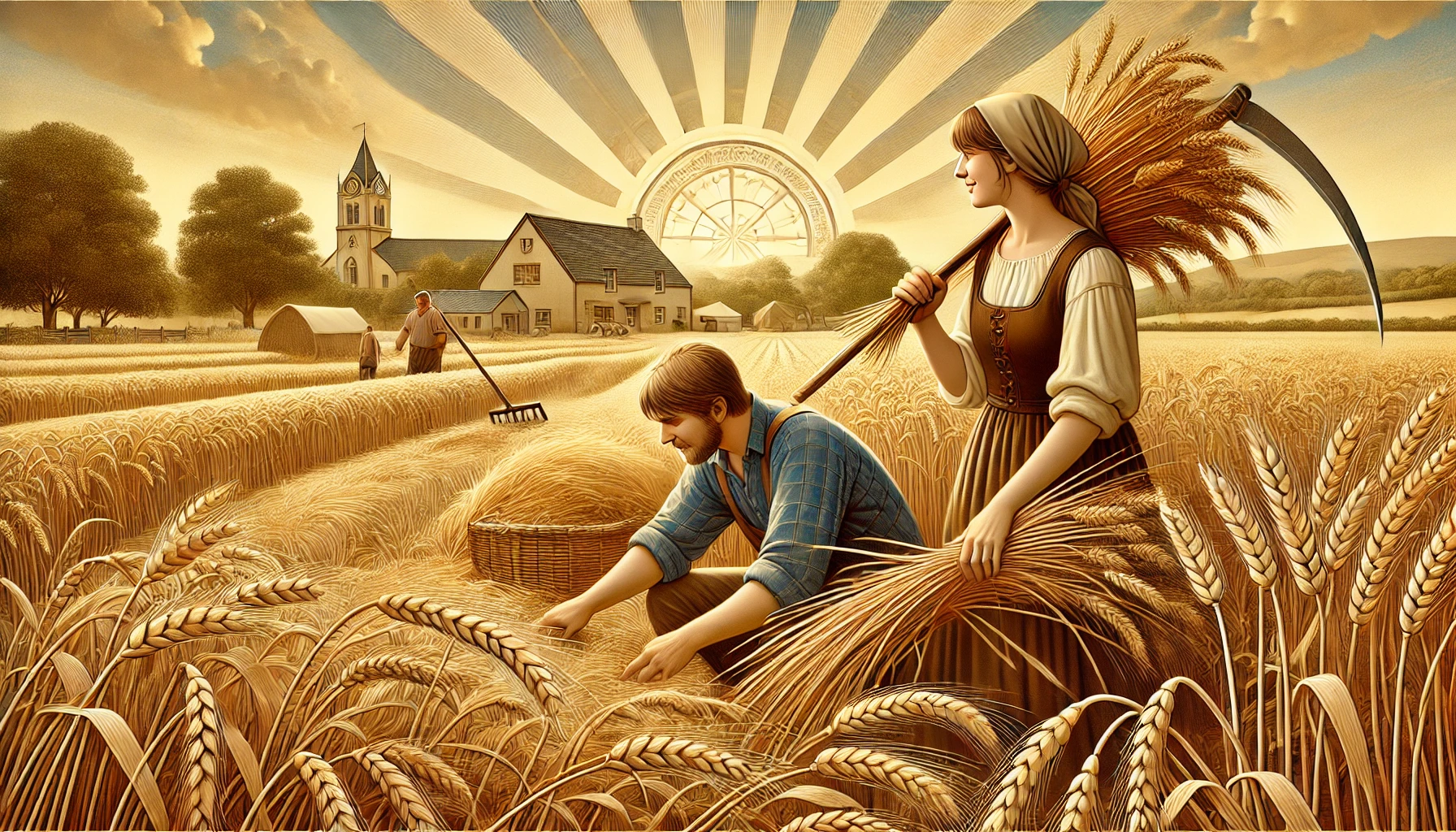
- This event has passed.
Lammas Day
August 1

Lammas Day, also known as Loaf Mass Day, marks an ancient Christian festival that celebrates the beginning of the harvest season. Historically observed on the 1st of August, this day is deeply rooted in gratitude for the bounty of the earth and the labor of those who cultivate it. It is one of the key moments in the agricultural calendar, signaling the end of the growing season and the start of the harvest period.
The festival’s name, ‘Lammas’, originates from the Old English words ‘hlaf-maesse’, which translate to ‘loaf mass’. In medieval times, it was customary for parishioners to bring bread made from the new crop to church, a symbolic offering of the first fruits to the Creator. This bread was then used in the Mass, underscoring the reliance on divine providence and the cycle of growth and renewal.
History and Meaning
Lammas Day holds a prominent place in cultural history, primarily in Europe, where it was first celebrated by early Christians. The day was not only about giving thanks for the harvest but also served as a reminder of the fragile balance between nature and human survival. This festival has its roots in earlier pagan traditions, where it was common to celebrate the first grain harvest with rituals and offerings to deities to ensure a continued abundance.
In England, Lammas was legally recognized as a holiday during the medieval period. Landowners would open their fields for common grazing, and it was an occasion for various community festivities, including markets, fairs, and games. These communal gatherings were not only about celebration but also reinforced social bonds and community cooperation, which were vital for the agricultural communities of the time.
Traditions and Rituals
Traditionally, Lammas Day involved numerous rituals centered around the themes of harvesting and gratitude. The creation of Lammas bread from the new crop was a key ritual. Families would bake special loaves of bread which were then brought to church to be blessed, symbolizing the sanctification of the harvest. In some regions, it was also traditional to make corn dollies from the last sheaf of the harvest, which were kept until the following spring to ensure the continuity of the spirit of the grain.
Another significant tradition was the ‘Lammas Fair’, often held at crossroads or near rivers. These fairs served as both a social and economic hub, providing an opportunity for people to sell their produce, buy goods, and exchange livestock. Traditional games, dance, and music were also integral parts of these celebrations, reflecting the joy and relief of a successful harvest.
Modern Celebration of the Day
Today, Lammas Day is celebrated by various communities around the world, though the form of observance can vary significantly. In some areas, it remains a predominantly religious festival, with special church services and the blessing of the bread. In others, Lammas has taken on a more cultural or spiritual significance, particularly within modern pagan and neopagan communities, such as Wiccans and Druids, who celebrate it as one of the eight sabbats in the Wheel of the Year.
The modern revival of Lammas in some regions has also seen the integration of environmentalism into the celebrations. It’s an occasion to promote sustainable agricultural practices and to raise awareness about the importance of preserving our natural resources. Workshops, educational programs, and community gardening projects are common features of contemporary Lammas festivities, making it relevant in today’s context of environmental concern.
10 Congratulations and Wishes
- “Wishing you a bountiful harvest and a joyful Lammas Day filled with prosperity and happiness!”
- “Happy Lammas! May your fields be fruitful and your heart be light as we celebrate the first harvest together.”
- “On Lammas Day, we gather to thank the earth. May your harvest be as rich and fulfilling as the love and hard work you’ve put into it.”
- “Cheers to the grain and to those who toil! Happy Lammas Day, may your pantry always be full!”
- “This Lammas, let us remember the past, cherish the present, and sow seeds for a future of abundance. Warm wishes on this blessed day.”
- “As we break bread this Lammas, may it remind us of the shared bounty that life offers. Have a wonderful harvest festival!”
- “Sending you warm wishes on Lammas! May your home and heart be filled with the joys of the harvest.”
- “Happy Lammas Day! Here’s to the fruits of your labor being as sweet as this festive day.”
- “May the spirit of Lammas fill your home with laughter, your heart with love, and your life with abundance.”
- “Celebrating you and the harvest this Lammas. May your days be filled with peace and your fields with plenty!”
10 Unusual Facts
- Lammas was once considered a time to settle debts in Scotland, where it was customary to clear all rents due by this day.
- The first recorded Lammas fair was held in the 12th century in Lincoln, England, and it continues to be an annual event.
- In some Celtic traditions, Lammas is also known as Lughnasadh, named after the god Lugh, associated with light and sun.
- Lammas is often linked with the tale of John Barleycorn, a folk character who personifies the barley crop and the beverages made from it.
- In early celebrations, it was common to include a ‘Lammas King and Queen’ who would lead the dances and festivities of the day.
- The tradition of making corn dollies can be traced back to indigenous European tribes who believed the spirit of the crop resided within them.
- Lammas is sometimes referred to as the “Feast of First Fruits,” as it was when monks would bring the first fruits of their monastic gardens to church.
- The Lammas lands were fields in medieval England that were communally grazed until Lammas time, after which they were harvested.
- Lammas marks the halfway point between the summer solstice and the autumn equinox, aligning it with other cross-quarter days.
- In some parts of England, tenants were historically required to present freshly harvested wheat to their landlords on or before Lammas, as part of their lease agreements.
10 Frequently Asked Questions
What is the spiritual significance of Lammas Day?
Lammas Day symbolizes the cycle of birth, growth, death, and rebirth, reflecting nature’s abundance and the human role in nurturing and harvesting it. It’s a time to express gratitude for the yield and to reflect on the symbiotic relationship between people and the earth.
How do modern pagans celebrate Lammas?
Modern pagans often celebrate Lammas as a sabbat in the Wiccan Wheel of the Year. The celebrations may include rituals such as baking Lammas bread, crafting corn dollies, holding feasts using seasonal produce, and conducting ceremonies that honor the deities associated with harvest and growth.
Why is bread so significant on Lammas Day?
Bread represents the transformation of the wheat crop into a sustaining element. It embodies the energy of the sun and the earth, turning simple grains into nourishing food. The act of baking and sharing Lammas bread is a profound reflection of community, sustenance, and gratitude.
Are there specific foods associated with Lammas?
Apart from bread, foods like barley soups, berry pies, and dishes made with seasonal vegetables are commonly associated with Lammas. These foods utilize the early harvests and often carry symbolic meanings of prosperity and community.
How can I incorporate Lammas traditions into my life if I’m not religious?
Lammas traditions can be adapted to celebrate the broader themes of gratitude, harvest, and environmental stewardship. Hosting a dinner with local, seasonal foods, volunteering at community gardens, or simply spending time in nature can be meaningful ways to observe the day.
What are some common symbols of Lammas?
Common symbols include grains, corn dollies, bread, and other harvest-related items. These symbols reflect the essence of Lammas as a harvest festival and are used in decorations, rituals, and crafts.
How did Lammas influence legal and economic practices in history?
Lammas had significant legal and economic implications, especially in medieval England. It marked the start of the harvest when common lands were opened for grazing, and it also acted as a benchmark date for settling debts and renewing contracts.
Can Lammas be celebrated in urban areas?
Absolutely! Urban dwellers can celebrate Lammas by supporting local farmers’ markets, participating in community gardening projects, or hosting potlucks that feature local and seasonal produce.
What is the difference between Lammas and Lughnasadh?
While both festivals celebrate the harvest, Lammas has its roots in Christian tradition, and Lughnasadh is a pagan festival primarily associated with the Celtic god Lugh. The two have often merged in modern celebrations but originated from different cultural backgrounds.
How has the celebration of Lammas changed over the centuries?
While its core as a harvest festival remains, Lammas has evolved from a predominantly religious observance to a more secular and inclusive celebration. It now encompasses a broader appreciation of agriculture and community, adapting to contemporary environmental and social contexts.
Conclusion
Lammas Day serves as a poignant reminder of humanity’s close bond with nature. As we navigate through modern life, the essence of Lammas teaches us to appreciate not only the fruits of our labor but also the natural cycles that sustain our existence. It’s a day to reflect on our contributions to the health of our planet and to recognize the simple yet profound joy of a harvest shared among community.
In celebrating Lammas, we not only honor an age-old tradition but also reaffirm our commitment to environmental stewardship and community resilience. The lessons of Lammas Day—gratitude, renewal, and interconnectedness—resonate deeply in a world that increasingly seeks sustainability and meaningful communal connections.
Author’s Opinion
Lammas Day is more than just an agricultural festival; it is a testament to human ingenuity and resilience. In a world striving for sustainability, Lammas embodies a celebration that can inspire contemporary society to reconnect with ecological cycles and embrace more sustainable living practices. Its historical depth and rich symbolism make Lammas a day of significant cultural and spiritual reflection.
SEO Description
Celebrate the essence of Lammas Day with our comprehensive guide on its history, traditions, and modern significance. Discover unique facts, explore FAQs, and find inspiring ways to honor this timeless harvest festival.




